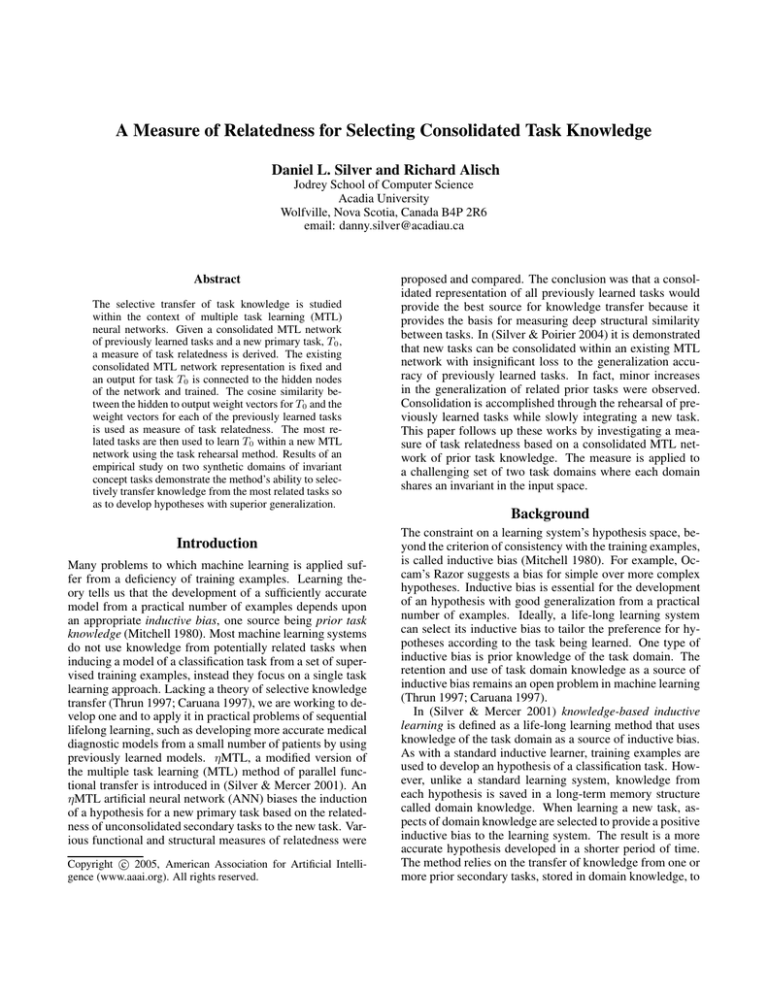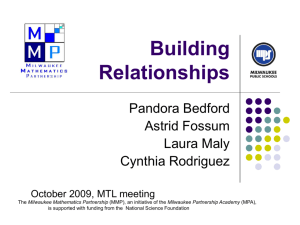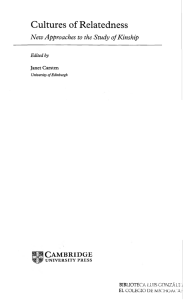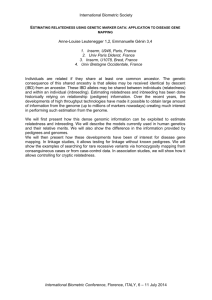
A Measure of Relatedness for Selecting Consolidated Task Knowledge
Daniel L. Silver and Richard Alisch
Jodrey School of Computer Science
Acadia University
Wolfville, Nova Scotia, Canada B4P 2R6
email: danny.silver@acadiau.ca
Abstract
The selective transfer of task knowledge is studied
within the context of multiple task learning (MTL)
neural networks. Given a consolidated MTL network
of previously learned tasks and a new primary task, T0 ,
a measure of task relatedness is derived. The existing
consolidated MTL network representation is fixed and
an output for task T0 is connected to the hidden nodes
of the network and trained. The cosine similarity between the hidden to output weight vectors for T0 and the
weight vectors for each of the previously learned tasks
is used as measure of task relatedness. The most related tasks are then used to learn T0 within a new MTL
network using the task rehearsal method. Results of an
empirical study on two synthetic domains of invariant
concept tasks demonstrate the method’s ability to selectively transfer knowledge from the most related tasks so
as to develop hypotheses with superior generalization.
Introduction
Many problems to which machine learning is applied suffer from a deficiency of training examples. Learning theory tells us that the development of a sufficiently accurate
model from a practical number of examples depends upon
an appropriate inductive bias, one source being prior task
knowledge (Mitchell 1980). Most machine learning systems
do not use knowledge from potentially related tasks when
inducing a model of a classification task from a set of supervised training examples, instead they focus on a single task
learning approach. Lacking a theory of selective knowledge
transfer (Thrun 1997; Caruana 1997), we are working to develop one and to apply it in practical problems of sequential
lifelong learning, such as developing more accurate medical
diagnostic models from a small number of patients by using
previously learned models. ηMTL, a modified version of
the multiple task learning (MTL) method of parallel functional transfer is introduced in (Silver & Mercer 2001). An
ηMTL artificial neural network (ANN) biases the induction
of a hypothesis for a new primary task based on the relatedness of unconsolidated secondary tasks to the new task. Various functional and structural measures of relatedness were
c 2005, American Association for Artificial IntelliCopyright gence (www.aaai.org). All rights reserved.
proposed and compared. The conclusion was that a consolidated representation of all previously learned tasks would
provide the best source for knowledge transfer because it
provides the basis for measuring deep structural similarity
between tasks. In (Silver & Poirier 2004) it is demonstrated
that new tasks can be consolidated within an existing MTL
network with insignificant loss to the generalization accuracy of previously learned tasks. In fact, minor increases
in the generalization of related prior tasks were observed.
Consolidation is accomplished through the rehearsal of previously learned tasks while slowly integrating a new task.
This paper follows up these works by investigating a measure of task relatedness based on a consolidated MTL network of prior task knowledge. The measure is applied to
a challenging set of two task domains where each domain
shares an invariant in the input space.
Background
The constraint on a learning system’s hypothesis space, beyond the criterion of consistency with the training examples,
is called inductive bias (Mitchell 1980). For example, Occam’s Razor suggests a bias for simple over more complex
hypotheses. Inductive bias is essential for the development
of an hypothesis with good generalization from a practical
number of examples. Ideally, a life-long learning system
can select its inductive bias to tailor the preference for hypotheses according to the task being learned. One type of
inductive bias is prior knowledge of the task domain. The
retention and use of task domain knowledge as a source of
inductive bias remains an open problem in machine learning
(Thrun 1997; Caruana 1997).
In (Silver & Mercer 2001) knowledge-based inductive
learning is defined as a life-long learning method that uses
knowledge of the task domain as a source of inductive bias.
As with a standard inductive learner, training examples are
used to develop an hypothesis of a classification task. However, unlike a standard learning system, knowledge from
each hypothesis is saved in a long-term memory structure
called domain knowledge. When learning a new task, aspects of domain knowledge are selected to provide a positive
inductive bias to the learning system. The result is a more
accurate hypothesis developed in a shorter period of time.
The method relies on the transfer of knowledge from one or
more prior secondary tasks, stored in domain knowledge, to
T0
Output Layer
T1
Tk
...
k
Tt
...
wjk
Task specific
representation
j
Hidden Layer
Common feature layer
Shared
internal
representation
wij
Input Layer
i
...
Figure 1: A multiple task learning (MTL) network with an
output node for each task being learned in parallel.
the hypothesis of the new task. Consequently, the problem
of selecting an appropriate bias becomes one of selecting the
most related task knowledge for transfer.
Knowledge Transfer in MTL Networks
Multiple task learning (MTL) neural networks are one of the
better documented methods of knowledge transfer (Caruana 1997). An MTL network is a feed-forward multi-layer
network with an output for each task that is to be learned.
The standard back-propagation of error learning algorithm is
used to train all tasks in parallel. Consequently, MTL training examples are composed of a set of input attributes and
a target output for each task. Figure 1 shows a simple MTL
network containing a hidden layer of nodes that are common to all tasks. The sharing of internal representation is
the method by which inductive bias occurs within an MTL
network (Baxter 1996). MTL allows two or more tasks to
share all or part of the common feature layer to the extent
to which it is mutually beneficial. The more that tasks are
related the more they will share representation and create
positive inductive bias.
Much of our research has focused on methods of selective knowledge transfer that distinguishes between knowledge from related and unrelated tasks. In (Silver & Mercer
2001), ηMTL, a modified version of MTL, is created to provide a solution to the problem of selective transfer of task
knowledge. ηMTL will be explained in the section on task
relatedness.
Sequential Learning through Task Rehearsal
In (Silver & Mercer 2002) the task rehearsal method was
introduced as a knowledge-based inductive learning system
that is able to retain and recall unconsolidated task knowledge. Building on the theory of pseudo-rehearsal (Robins
1995), previously learned but unconsolidated task representations are used to generate virtual examples as a source of
functional knowledge. After a task Tk has been successfully learned (to a specified level of generalization error),
its hypothesis representation is saved in domain knowledge.
This representation acts as a surrogate for the space of inputoutput examples that defines task Tk . Virtual examples of
the input-output space for Tk can be produced (with the
same level of generalization error) by passing inputs to the
domain knowledge representation for Tk and recording the
outputs. When learning a new task, T0 , the domain knowledge representations for tasks T1 ...Tk ...Tt are used to generate corresponding virtual output values from the set of T0
training examples. The resulting set of virtual examples is
used to relearn or rehearse the domain knowledge tasks in
parallel with the learning of T0 in an MTL or ηMTL network. It is through the rehearsal of previously learned tasks
that knowledge is transferred to the new task.
A method of sequential consolidation of task knowledge
using an MTL network and Task Rehearsal is proposed and
tested in (Silver & Poirier 2004). This method overcomes
the stability-plasticity problem originally posed by (Grossberg 1987) taken to the level of learning sets of tasks as opposed to learning sets of examples. The stability-plasticity
problem is the difficulty of learning a new example within a
neural network while trying to maintain knowledge of previously learned examples. The paper shows that the consolidation of new task knowledge without loss of existing task knowledge is possible given sufficient number of
training examples, sufficient internal representation for all
tasks, slow training using a small learning rate and a method
of early stopping to prevent over-fitting and therefore the
growth of high magnitude weights. The benefits of retaining domain knowledge in a consolidated form are (1) more
efficient and effective storage of individual hypotheses and
(2) the basis by which to determine the structural similarity
between hypothesis representations. The following section
proposes one method of measuring the relatedness between
a new primary task and the tasks knowledge retained with a
consolidated MTL network.
Task Relatedness and Selective Transfer
The above background material has led to a theory of selective knowledge transfer from an MTL network of consolidated domain knowledge. In this section we summarize those aspects of the theory that are concerned with (1) a
framework for adjusting inductive bias within an MTL network via a measure of task relatedness (2) the nature of task
relatedness and (3) a method of using consolidated MTL domain knowledge to measure task relatedness based on structural similarity.
Framework for a Measure of Task Relatedness
Consider an objective function to be minimized by the BP
algorithm across all task outputs of a MTL network that focuses on the development of the best hypothesis for the priP
mary task. Let Ê = E0 + k Ek , where Ek is the error
on the training examples for the secondary tasks and E0 is
the error on the primary task training examples. By gradient
descent the appropriate change to a weight wjk at an out∂ Ê ∂Ek
put node k is given by ∆wjk = −η ∂E
where η is
k ∂wjk
∂ Ê
the learning rate. Under these conditions, ∂E
, the rate of
k
change of the overall error with respect to the rate of change
of the error for task k, can be considered the weight of importance of task k for learning the primary task. We define
this weight of importance to be the measure of relatedness,
Rk , between the primary task and each of the secondary
∂Ek
tasks; that is ∆wjk = −ηRk ∂w
. Thus, an appropriate
jk
measure of relatedness, Rk , for a secondary task, Tk , must
regulate the impact of the task error, Ek , on the formation
of shared internal representation. This modified version of
the standard back-propagation learning algorithm for MTL
is called the ηMTL algorithm because RK tailors the learning rate η for each secondary task (Silver & Mercer 2002).
Let R0 = 1 for the primary task, T0 , and let 0 ≤ Rk ≤ 1
for all other tasks, Tk , thereby constraining the learning rate
for any secondary task to be at most η. If Rk = 1 for all k,
we have standard MTL. Alternatively, if R0 = 1 and Rk = 0
for all k, we have standard single task learning (STL) of the
primary task. In this way, the ηMTL framework generalizes
over STL and MTL.
Nature of Task Relatedness
Critical to the transfer of knowledge from a pool of secondary tasks to a primary task is some measure of relatedness between those tasks (Thrun 1997; Caruana 1997). A
brute force approach to determining the relatedness between
the primary task and each secondary tasks would be to have
the learning system learn T0 in parallel with every other secondary task and record the effectiveness of each T0 hypothesis. However, if combinations of secondary tasks are considered then the method would be impractical because of
the factorial growth in time complexity. The next section
discusses two categories of a priori measures of relatedness
that attempt to overcome this problem.
Measures of Relatedness
Measures of relatedness can be grouped into at two broad
categories (Silver & Mercer 2001); (1) surface similarity
measures or (2) structural similarity measures. Surface similarity measures are estimates based on shallow, easily perceived, external similarity which is a measure of the external
functional similarity. Surface similarity measures are most
typically based on mathematical relationships between the
output values of the primary task and each secondary task;
for example the coefficient of linear correlation, r, between
the target values of Tk and T0 . We have previously used a
measure of relatedness Rk = |r| with some success (Silver
& Mercer 2001).
The current paper is interested in judging relatedness between pattern recognition tasks where each task must learn
an invariant of the concept pattern in the input space. Unfortunately, surface similarity measures suffer from an inability
to capture such complex invariant relations between tasks.
Structural similarity measures are estimates of relatedness
based on deep, often complex, internal feature similarity
such as the degree to which two MTL hypotheses utilize
shared internal representation to produce accurate approximations to tasks. Cognitive researchers believe that knowledge transfer begins by using surface similarity as the preliminary search key into domain knowledge (Robins 1995).
Structural similarity is subsequently used to scrutinize the
selected tasks at a finer level of detail — at a level where
the internal “hidden” representation of the tasks are compared. We propose that structural measures provide an opportunity to capture the measure of relatedness between invariant tasks.
Structural similarity measures can be based on the similar use of the common feature layer by each task specific
portion of an MTL network, or the similarity of the weight
space representations in the task specific portions of an MTL
network. Consider the ηMTL network shown in Figure 1.
Each secondary hypotheses hk differs from the primary hypothesis h0 only in terms of their common feature layer node
to output node weight vectors, W0 and Wk . Co-linearity of
W0 and Wk is a measure of the relatedness between h0 and
hk . Let θ be the angle between Wk and W0 . A measure of
structural similarity is given by Rk = | cos θ|.
Consolidated MTL Networks & Task Relatedness
Consider a consolidated MTL 3-layer network (as per Figure 1) with a set of previously learned tasks such as Tk from
a domain and training data for a new primary task T0 . We
propose to measure the relatedness of the new task to the
prior tasks in the following way. First, fix the representation of the exiting MTL network including the hidden to
output weights, Wk , for each task. Second, add an output
node for T0 to the hidden nodes and set its vector of connection weights, W0 , to small random values. Third, train the
network to learn T0 as accurately as possible using crossvalidation. Finally, determine the mean absolute cosine of
the angle, | cos θ|, between the weight vectors W0 and each
Wk . Set Rk equal to this cosine similarity estimate. The
preliminary training of the primary task hypothesis does not
take long because the only weights that changed are in W0 .
Two methods are proposed for selecting related tasks
based on Rk . The first method called “0.5 cut-off” selects
all tasks within the consolidated network with an Rk > 0.5.
The second method called “average Rk cut-off” calculates
the mean Rk across all tasks within the consolidated network, R¯k . It then selects all tasks with an Rk > R¯k .
One significant challenge for this method concerns the accuracy of the preliminary hypothesis for T0 . Clearly, the validity of the weights depends upon the generalization accuracy of the hypothesis. If a sufficiently accurate hypothesis
cannot be developed then it is reasonable to conclude that
there are no related tasks within the consolidated domain
knowledge MTL network. Consequently, there is no value
in using the measures of relatedness to selectively transfer
prior knowledge. For the purposes of this paper, the Rk
value is accepted only if the preliminary hypotheses for T0
are learned with a sufficient level of mean accuracy. The
issue of preliminary training accuracy will be investigated
further in future work.
Empirical Studies
To test the hypothesis of selective functional transfer using a
consolidated MTL network and the weight-based structural
measure of task relatedness, a series of experiments were
conducted using tasks from two distinct domains. Both domains share the same inputs and contain nonlinearly separable tasks that identify invariant concepts in the input space.
Domain I1
A B
C
D
E
F G
Domain I2
A B
C
D
E
F G
esis for T0 will be considered the most related. A surface
similarity measure such as correlation does poorly on judging the relatedness between any tasks a prioi. For example the |r| values between I1 T0 and each of the other eight
tasks I1 T1 , ..., I1 T4 , I2 T1 , ..., I2 T4 are respectfully 0.1137,
0.1200, 0.1078, 0.1156, 0.1137, 0.1200, 0.1078, 0.1156.
Experiments
Figure 2: The two Invariant domains. Each task must recognize a pattern of three attributes that are invariant over the
input space in two different ways.
These tasks were chosen because they are not amenable to
simple surface measures of relatedness like linear correlation.
The Invariant Domains
Figure 2 characterizes the tasks from the two domains. Both
domains exhibit translational invariance in the shared input
space; for each task a pattern of three input values is invariant over the seven attributes. Each input attribute can have
three possible values: 0.5 meaning background (B), < 0.5
meaning a low (L) value, and > 0.5 meaning a high (H)
value. Each task in each domain identifies one of five patterns in the inputs: the primary task, T0 , identifies the pattern
HLH and the secondary tasks identify each of the following
patterns: T1 , HHH; T2 , LHL; T3 , LLL and T4 , LHH.
The difference between the domains is the mapping of
the three invariant attribute values over the seven inputs. Invariant domain one, I1 , contains tasks where the pattern is
mapped to any three contiguous inputs (with wrap-around);
for example BLHHBBB. Invariant domain two, I2 , contains tasks with the pattern mapped to five contiguous inputs with a background input between each attribute (with
wrap-around); for example BLBHBHB. Labelling the inputs as A through G, the five tasks of each domain can be
expressed mathematically, for example task I1 T0 would be:
(A > 0.5∧B < 0.5∧C > 0.5)∨(B > 0.5∧C < 0.5∧D >
0.5) ∨ ... ∨ (G > 0.5 ∧ A < 0.5 ∧ B > 0.5). This problem is
equivalent to learning to recognize a 3-pixel pattern in a data
stream that is seven pixels wide, independent of the pattern’s
starting position.
The examples were generated as follows: all inputs were
initialized to the background value, three random attribute
values were generated and mapped to a random starting input and finally the target output (1 if true and 0 if false) was
generated for each task according to the task’s attribute pattern. The examples for each task were evenly split across all
seven possible mappings of the patterns to the inputs.
The tasks of the two domains should compete for internal
representation at the common feature layer of the consolidated MTL network. We expect that I1 tasks will tend to
share a subset of internal representation (hidden nodes) different from that of the I2 tasks that captures the I1 invariance
mapping. Ultimately, those secondary tasks that contribute
most positively to the development of an accurate hypoth-
The following experiments provide evidence that a structural measure of relatedness based on consolidated domain
knowledge can be used to promote a positive transfer of
knowledge for the development of a more effective primary
hypotheses. The first experiment examines the learning the
primary task, T0 , under STL and ηMTL using all tasks of
both domains, all tasks of each domain, and each individual
task. This provides a base line for learning T0 and the relatedness of T0 to each of the secondary tasks. The second experiment demonstrates (1) the calculation of Rk based on the
representation of the consolidated MTL network containing
the secondary tasks of both domains and (2) the benefit of
using Rk for learning T0 under ηMTL.
The consolidated MTL hypotheses for all secondary tasks
were developed using 500 training and 500 validation examples and then tested against the 1000 test examples. The hypotheses were shown to have accuracies no less than 90%.
The preliminary training and final training of the primary
task I1 T0 uses an impoverished training set of only 100
training examples. This is accomplished by marking the target value for 400 of the the primary task examples as unknown. In our software target values marked as unknown
make zero contribution to weight modifications for that task.
The neural networks used in the experiments have an input layer of 7 nodes, one hidden layer (common feature
layer) of 14 nodes, and an output layer of 9 nodes, one for
each secondary task and I1 T0 . Each node uses a standard
sigmoid activation function. The number of hidden nodes is
sufficient for all tasks. One hidden node is required to act
as a receptive field for each of the seven possible attribute
mappings for each domain. Therefore, 14 hidden nodes provide sufficient internal representation for the two domains
of tasks under MTL (Caruana 1997). In both experiments
the mean squared error cost function is minimized by the
BP algorithm. The base learning rate, η, is 0.005 and the
momentum term is 0.9. Random initial weight values are
selected in the range −0.1 to 0.1 for all runs.
One trial consists of 5 repetitions using different random
initial weight vectors. To reduce experimental variance, the
same set of initial weights are used by the various learning
methods during one repetition. Performance of the methods
is based on the generalization accuracy of the hypotheses for
the primary task developed from the impoverished training
set. Generalization accuracy is the mean proportion of correct classifications made by the primary hypotheses against
an independent test set over the repetitions. Classification is
subject to a cut-off value of 0.5 (any example with a value
≥ 0.5 is considered class 1). A difference of means hypothesis test (1-tailed, paired) based on a t-distribution will determine the significance of the difference between the mean
accuracy for any two trials.
0.88
0.86
Accuracy
0.84
0.82
0.8
0.79
0.80 0.79
0.78
0.81 0.80
0.82 0.81
0.83
0.76
0.74
0.82
0.84
0.78
0.78
0.72
STL I1+I2
I1
I2
I1T1
I1T2
I1T3
I1T4
I2T1
I2T2
I2T3
I2T4
Figure 3: Experiment 1: Accuracy of T0 hypotheses under
inductive bias provided by various secondary tasks.
Experiment 1: Inductive bias from various tasks. This
experiment examines the inductive bias provided to the primary task, T0 , within an ηMTL network when learned in
parallel with a variety of secondary tasks. The following parameter settings are tested during 12 trials: the primary task,
T0 , with no secondary tasks (all Rk = 0.0); all 8 secondary
tasks of both domains, I1 and I2 (all Rk = 1.0); the 4 secondary tasks of domain I1 ; the 4 secondary tasks of domain
I2 ; and 8 trials of ηMTL where only one of the secondary
tasks is learned in parallel with T0 (R0 = 1.0, Rk = 1.0,
Ri = 0.0, i 6= k for trial k).
Results and Discussion. Figure 3 presents the performance results for hypotheses developed by each of the learning methods over 5 repetitions. Shown are the mean accuracy (and 95% confidence interval) on a 1000 example test
set. The hypotheses for the primary task developed from
the impoverished training set (100 training examples) using
STL performed the worst on the test set. Parallel learning
of all secondary tasks from domains I1 and I2 under ηMTL
developed the best hypotheses with an accuracy of 85%. As
expected the most helpful domain of tasks were those of I1
with a statistical difference of 3% (p=0.091) over I2 .
When R0 = 1.0 and only one other Rk = 1.0, the ηMTL
method isolates the inductive bias to task Tk . Figure 3 shows
that the most consistently effective T0 hypotheses were those
developed in parallel with tasks T2 , T3 from domain I1 and
surprisingly T1 , T2 and T4 from domain I2 . The positive
inductive bias from the domain I2 tasks was not expected
nor is it in agreement with the results from MTL learning
with all tasks of each domain. We conclude that the mixture
of tasks being learned in parallel has a significant impact on
the inductive bias from each task. In additional, we conclude that there are similarities between the tasks across the
domains in spite of our attempt to create difference in the
invariants.
Experiment 2: Selective Inductive Bias Using Rk . This
experiment demonstrates the calculation of the Rk values
based on the use of an existing MTL network that contains
Task
I 1 T1
I 1 T2
I 1 T3
I 1 T4
I 2 T1
I 2 T2
I 2 T3
I 2 T4
Rk = | cos θ|
0.158
0.430
0.585
0.227
0.133
0.181
0.141
0.604
0.5 cut-off
ave. Rk cut-off
selected
selected
selected
selected
selected
Table 1: Measure of relatedness values and the selection of
most related tasks.
accurate representations of all I1 and I2 secondary tasks.
It then examines the inductive bias provided to the primary
task, T0 , within an ηMTL network when the Rk values are
used to select the most related tasks for knowledge transfer. Both the “0.5 cut-off” and “average cut-off” methods of
using Rk to select the most related tasks are tested.
A 7-14-8 MTL network was used to develop accurate hypotheses for the eight secondary tasks T1 , ..., T4 of the two
domains. As per our theory, the representation of the existing MTL network including the hidden to output weights,
Wk , was then fixed. An output node for T0 was added by
connecting it to the hidden nodes and setting its weights,
W0 , to small random values. The network was trained five
different times to learn T0 using an impoverished training
set (100 examples). The mean absolute cosine of the angle,
| cos θ|, between the weight vectors W0 and each Wk was
calculated. This mean value is used as the value for each
Rk . The Rk values were deemed acceptable if the T0 task
trained to a level of 70% accuracy or better. The final selections of most related tasks were based on the “0.5 cut-off”
and the “average Rk cut-off” method as described earlier.
The final training of the primary task, T0 , uses the same
network and parameter configuration as Experiment 1; however, all connection weights are initialized to small random
values. The Rk values for the most related tasks were set to
1.0; all other Rk values were set to 0.0. This ensures that
only the related tasks will be learned in parallel with T0 .
Results and Discussion. Table 1 shows the Rk values
generate by the cosine similarity using the consolidated
MTL network weights. Observe the similarity of these values to that of the inductive bias provided to the T0 hypotheses by each of the domain knowledge tasks shown in Figure 3. The linear correlation, r 2 , of these values is 0.712,
indicating a good deal of similarity. Only the Rk values for
I2 T1 and I2 T2 deviate significantly from the inductive bias
results. This provides us with some confidence that the proposed measure of task relatedness has merit.
Figure 4 presents the performance results for T0 hypotheses developed by each of the learning methods using impoverished training sets over 5 repetitions. Shown are the mean
accuracy (and 95% confidence interval) on a 1000 example
test set. The T0 hypotheses developed using the measure
of relatedness methods perform as well as or better than all
0.88
0.86
Accuracy
0.84
0.82
0.85
0.84
0.8
0.78
0.80
0.76
0.74
0.84
0.83
0.78
0.72
STL
I1+I2
I1
I2
0.5 Cut-off
Ave.Cutoff
Figure 4: Experiment 2: Accuracy of T0 hypotheses under
inductive bias provided by selective transfer of secondary
task knowledge.
other hypotheses. This includes those developed under the
various choices of tasks or domains of Figure 3. In particular, the hypotheses developed under the 0.5 cut-off method
that chose I1 T3 and I2 T4 as the most related tasks is statistically better (p < 0.092) than all variations accept when T0
is learned in parallel with all tasks (I1 + I2 ).
by the method correlated very strongly with the performance
of the T0 hypotheses when learned with each of the individual secondary tasks (r 2 = 0.712). This suggests that the
cosine similarity measure captures aspects of the sharing of
internal representation between T0 and secondary task hypotheses within the consolidated MTL network.
The “0.5 cut-off” method produces hypotheses with the
highest mean accuracy over all other variations. The method
consistently chose I1 T3 and I2 T4 as the most related tasks.
However, the selective transfer results are not significantly
better than when all tasks are learned at the same time in
one MTL network. Our goal in future research is to ensure
greater diversity between the two task domains.
Will the measure of relatedness scale up? Theoretically,
the method of measuring task relatedness should scale to
large numbers of secondary tasks within a consolidated
MTL network. Adjustment of an appropriate cut-off will
ensure only the most related tasks are selected for learning
within an ηMTL network with the new task. The larger
problem is that of sequential consolidation of new task
knowledge into an ever increasing consolidated MTL network. We have previously reported advances in this area
(Silver & Poirier 2004) and are currently investigating the
effect of curriculum and practise on consolidation.
Acknowledgement: This research has been funded in part
by the Government of Canada through NSERC.
Summary and Conclusion
References
This paper has introduced a method of measuring task relatedness between a new primary task, T0 and previously
learned tasks consolidated within an MTL neural network.
The measure is based on the structural similarity between
the representation of each existing task Tk and a preliminary
hypothesis developed for T0 from the consolidated MTL
network. The resulting measures, Rk , are used to select
those secondary tasks that are most related to T0 for learning
within a new MTL network. We use an ηMTL network for
learning T0 because it provides a framework for controlling
the selection of secondary tasks and therefore inductive bias
through knowledge transfer.
The results of Experiment 1 indicate that a significant
transfer of knowledge occurs between secondary tasks from
the two invariant domains of tasks to the primary task. It
further indicates that in composite, tasks from the same domain I1 provide the strongest positive inductive bias to T0 .
However, the experiments also show that certain tasks from
invariant domain I2 positively bias the development of a hypothesis for T0 . In fact they do so more individually than
they do in composite. We conclude that (1) the mixture of
tasks being learned in parallel has a significant impact on the
transfer of knowledge from each task and (2) that there are
similarities between the tasks that were not anticipated. This
indicates that further work is required on the nature of relatedness between tasks within a consolidated representation.
The results of Experiment 2 show that a structural measure of task relatedness based on consolidated domain
knowledge can be used to selectively transfer knowledge and
adjust inductive bias. The measures of relatedness returned
Baxter, J. 1996. Learning model bias. In Touretzky, D. S.;
Mozer, M. C.; and Hasselmo, M. E., eds., Advances in Neural Information Processing Systems, volume 8, 169–175.
Caruana, R. A. 1997. Multitask learning. Machine Learning 28:41–75.
Grossberg, S. 1987. Competitive learning: From interactive activation to adaptive resonance. Cognitive Science
11:23–64.
Mitchell, T. M. 1980. The need for biases in learning
generalizations. Readings in Machine Learning 184–191.
ed. Jude W. Shavlik and Thomas G. Dietterich.
Robins, A. V. 1995. Catastrophic forgetting, rehearsal, and
pseudorehearsal. Connection Science 7:123–146.
Silver, D. L., and Mercer, R. E. 2001. Selective functional
transfer: Inductive bias from related tasks. Proceedings of
the International Conference on Artificial Intelligence and
Soft Computing (ASC2001) 182–189.
Silver, D. L., and Mercer, R. E. 2002. The task rehearsal
method of life-long learning: Overcoming impoverished
data. Advances in Artificial Intelligence, 15th Conference
of the Canadian Society for Computational Studies of Intelligence (AI’2002) 90–101.
Silver, D. L., and Poirier, R. 2004. Sequential consolidation of learned task knowledge. Lecture Notes in Artificial
Intelligence, 17th Conference of the Canadian Society for
Computational Studies of Intelligence (AI’2004) 217–232.
Thrun, S. 1997. Lifelong learning algorithms. Learning to
Learn 181–209.1 Kluwer Academic Publisher.






